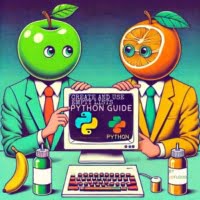Programming / Coding
18 Jun 2024
Python Join List to String: Step-by-Step Guide

Converting lists to strings in Python has been a common operation for us at IOFLOOD while working to improve our data handling software. This process combines list elements into a single string, enhancing data readability. Today’s article delves into the methods for joining a list to a string in Python, providing practical examples to assist
18 Jun 2024
Joining Lists in Python: A Step-by-Step Tutorial

Joining lists in Python is an essential task for consolidating data in our scripts at IOFLOOD. In our experience, this operation ensures consistent merging of multiple lists into one cohesive data set. Today’s article aims to provide valuable insights and examples to assist our dedicated bare metal servers customers. In this guide, we’ll walk you
18 Jun 2024
Python Add to List | Methods, Syntax, Examples

Adding an element to a list in Python is a common technique needed when scripting data processing tasks at IOFLOOD. In our experience, this task allows for dynamic data updates and expansions, all within a simple method. This article shares our techniques and best practices for adding elements to lists in Python, helping our dedicated
18 Jun 2024
Using Python to Filter a List: Targeted Guide
Filtering a list in Python is a a technique we often use when working to automate processes at IOFLOOD. In our experience, this process assists with consistent extraction of specific elements that meet defined criteria. Today’s article explains how to filter a list in Python, providing valuable insights and examples to assist our bare metal
18 Jun 2024
Python Empty List | Guide to Using Empty Lists in Python

Creating and using empty lists in Python is a pivotal step we utilize when developing software at IOFLOOD. In our experience, empty lists serve as a starting point for data collection and manipulation, and aids in clean and concise code. This article shares our techniques and best practices for creating and using empty lists in
18 Jun 2024
Learn Python: How To Check If a List Is Empty?

Checking if a list is empty in Python is sometimes needed when we validate data sets for scripts at IOFLOOD. In our experience, this task ensures that data processes can proceed accurately by confirming the presence of list elements. Today’s article explains how to check if a list is empty in Python, providing valuable insights
17 Jun 2024
Removing Items from Lists in Python: Easy Techniques

Easily removing items from lists in Python is a hurdle we often encounter while scripting for use at IOFLOOD. This process is especially important during script setup, for maintaining clean and consistent data sets. In this article, we will share our best practices and examples to help our dedicated hosting customers manage their data with
17 Jun 2024
Learn Python: How To Sort a List with sort() and sorted()

Properly sorting a list in Python is a basic task, yet it is essential when organizing data for use in our scripts at IOFLOOD. In our experience, sorting lists makes data more accessible and easier to analyze. Today’s article aims to provide valuable insights and examples to assist our customers that are having questions on
17 Jun 2024
Python Reverse List: Complete Guide (With Examples)

While working to automate our data analysis programs at IOFLOOD, we had the pleasure of becoming familiar with the methods of reversing lists in Python. Although it is a basic task, list reversal plays a significant role in data processing as it ensures that data is organized in the desired sequence. This article details the
17 Jun 2024
Finding the Length of a List in Python (With Examples)

Determining the length of a list has many use cases when scripting data processing and analysis tasks, especially for us at IOFLOOD. As we have gotten familiar with the various available methods, we have created this article to share our techniques and best practices for finding the length of lists in Python, aiding our dedicated